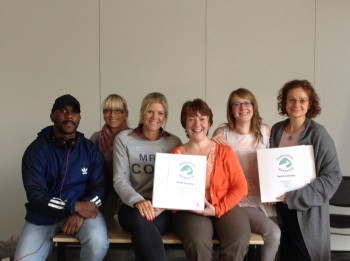Destination Wellbeing Practitioner – The Health Practitioner of the Future
 On 12-14th May in London, Integrative Health Education hosted Destination Wellbeing® – Health Evolution which is a three-day course that introduces Emma Lane’s holistic approach to creating true and sustainable wellbeing based on her 20 years of industry experience.
On 12-14th May in London, Integrative Health Education hosted Destination Wellbeing® – Health Evolution which is a three-day course that introduces Emma Lane’s holistic approach to creating true and sustainable wellbeing based on her 20 years of industry experience.
Practitioners attending this unique training learn tried and tested effective techniques that are not generally utilised in the health industry giving them ways to differentiate themselves and get ahead of the competition. Taking principles from many healing methodologies, from naturopathy through to Chinese medicine, Destination Wellbeing prepares attendees to become Destination Wellbeing Practitioners who know how to stop the formation of ‘dis-ease’ in the body to prevent more serious health conditions.
We, at Integrative Health Education, believe that the best way to show the value behind our courses is to share the experience of our students. That’s why today, we are joined by Maya Petrova – a Holistic Nutritionist and NLP Master Practitioner who will share why she chose to attend the course and what learnings she took from it.
IHE: Hello Maya and thank you for your willingness to give us your feedback. Can you tell us why you chose to attend Destination Wellbeing?
I’ve been to different courses and seminars after I graduated as a Nutritionist but in all of them I felt that something was missing – a way of linking it all together – the mind, the body and the spirit. When I started my practice, I was mainly focused on bodybuilding and fitness until I came across Emma Lane who helped me realise that there was more to health than physical appearance.
From attending previous courses with Emma, I knew that with her there is always something unique to be discovered that not only works best but is also easily applicable. I also trust her reputation and years of experience in successfully helping practitioners not only regain their health but also improve their business. I believe that we are here to grow as a group and to learn and experience life with others. As a practitioner, I feel a lot more confident in using the education from someone who has been there, done it, succeeded at it rather than spending my days, reading online, listening to many experts and trying to figure it all out alone. That’s why I chose Destination Wellbeing – I knew it would have all aspects of health linked together in a way that I can easily use with my clients and feel confident in my success.
IHE: What did you learn from the course that made the difference for you as a practitioner?
Destination Wellbeing teaches you to assess health from a 12-pillars perspective – stress management, nutrition, self-purpose, happiness, me-time, breathing, movement, digestion, detox, mindfulness, energy creation and relationships. As a practitioner, I cover some of them in my approach but with Destination Wellbeing I see how they all link together and most importantly how if we only focus on improving a few of these pillars, we can see positive effects on the remaining. I also didn’t realise how much of an impact the areas of self-purpose, me-time and happiness can have on our wellbeing. Emma made me realise that each of us have a responsibility to firstly take care of ourselves and to make sure we take appropriate me-time daily.
I was also impressed by the tools in each section to improve that particular wellbeing area from chi exercises, questionnaires to assess self-purpose and values, to goal setting sheets and tips for changing habits.
Emma has also masterfully integrated some NLP aspects, such as the mirroring and matching techniques and learning styles to make sure we develop good relationships with each client too. I didn’t expect to have aspects of business training in the course so that was a positive surprise.
Another unique aspect is the structure of each section. Emma first explains the research and science behind each pillar which is helpful when talking to clients as some like to hear the stats to get the importance of making a change. This research-driven approach is found in the whole manual, further reinforced by Emma’s own experience which gives us more confidence in applying the tools. Emma has also done a great job in creating moving and inspiring visuals, such as the wellbeing characters to use with clients who are visual or the wellbeing continuum to show them their current level of wellbeing.
IHE: How did the course change you and your understanding of wellbeing?
The relationships and self-purpose sections were turning points for me. I learned that our values determine how we make daily decisions and how we live our life, what is acceptable and what is not, where the boundaries are so we can create good relationships with others. We also talked about the inner I which is the inner self and is a crucial relationship in life.
Understanding wellbeing from the aspects of movement and breathing was also eye-opening. As practitioners, we often think of movement just as exercise but it involves much more, such as the way we move in the day because our ancestors didn’t spend their time on a desk or in the car.
Overall, Destination Wellbeing is for me like a Book of Life – teaching you what to do, how to think, move, drink, eat, breathe and act if you want to live a good life. The ‘power book’, telling you the why and the how so when you leave the classroom you can not only transform your life but also the lives of others. There are many titles for practitioners in the health industry – Nutritionist, Health Coach, Naturopath, etc. In my opinion, the practitioners of the future, the ones that will be able to ‘heal’ and ‘treat’ the whole being are the Destination Wellbeing Practitioners. If we lead by example, as Emma teaches us and does herself, then we can truly make a positive difference in this world!
IHE: What do you want to say to anyone who is considering Destination Wellbeing?
I know that when you read the sections’ names, some of you may think that you know enough in those areas and you will probably not gain much. As someone who had these thoughts too and who has just gone through the training, let me tell you that you will gain a lot – from a system of wellbeing mapping that is so intelligently designed that you will be able to much better understand your wellbeing and that of your clients, to a deep understanding of yourself and how life works, and what to do to create your dreams.
This course shapes you not just as a practitioner on a professional level but also as an individual on a personal level. Take the opportunity this year in either Wakefield or California and see for yourself. I am happy to speak to anyone who is considering the course and share additional insight. The more Destination Wellbeing Practitioners we are, the better the world will be. Maya Petrova, Destination Wellbeing Practitioner – www.healthandbalance.org
For more information on this course please click here.



